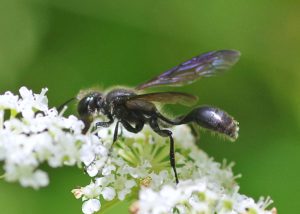Howdy, BugFans,
The BugLady will always associate this wasp with the pandemic. In early summer, she got an email from a BugFan who, because she was working from home (and maybe looking out the window a little bit??), noticed that the track of one her sliding windows had been stuffed with grass. What was going on? The BugLady sent her some info on Grass-carrying wasps and wished that she would see one someday).
Fast-forward to the Water Hemlock Wildflower Watch (of recent BOTW fame). As she worked her way through the pictures she took on those outings, the BugLady suspected that the fuzzy, little Hymenopteran that she saw was, indeed, a Grass-carrying wasp. Here are some nicer pictures: https://bugguide.net/node/view/1412306/bgimage, and https://bugguide.net/node/view/1592431/bgimage.
Grass-carrying wasps are, small, benign members of the wasp family Sphecidae, the Thread-waisted wasps (“thread-waisted” because their abdomen is connected to the thorax by a thin stalk called a “petiole”). Some Sphecids are spectacular in size, shape, and color https://bugguide.net/node/view/819298/bgpage, https://bugguide.net/node/view/1856936/bgpage, https://bugguide.net/node/view/68796/bgpage, https://bugguide.net/node/view/1572229/bgimage (all of these wasps have been featured in their own BOTWs).
Sphecids are solitary wasps; most make a nest in the ground that they provision with paralyzed invertebrates for their offspring. The adults are pollinators that sip nectar from flowers (one article said that Sphecids prefer white flowers), drink some of the juices of the prey they collect, visit deposits of aphid honeydew, or even take advantage of hummingbird feeders https://bugguide.net/node/view/1401700/bgimage.
Counterintuitively, the Mexican grass-carrying wasp (Isodontia mexicana) is the most widespread (https://bugguide.net/node/view/34920/data) of the six genus members that occur in North America. Bugguide.net lists a pretty reliable (but unofficial) field mark for the MGCW – a brown spot near the base of the petiole, and through the Joys of Photoshop, the BugLady was able to see it on her wasp https://bugguide.net/node/view/817656/bgimage. Besides North America, they’ve also made their way to the UK, to Europe as far east as Crimea, and to Midway Atoll. Not surprising considering their secretive nesting habits.
They’re found in gardens, grasslands and woodland edges, and when they’re not taking advantage of man-made “bee hotels” https://bugguide.net/node/view/1706561/bgimage and window ledges, they nest in crevices and cavities in wood, in hollow plant stems https://bugguide.net/node/view/231614, and in tunnels made by other animals (which they clean out before they add their own nest materials). Unlike many Sphecids, MGCWs mostly nest above the ground.
Females gather blades of grass and stuff them into a nest site to form a lining (picture a ¾” wasp trailing a long piece of grass through the air https://bugguide.net/node/view/1560148/bgimage). At the start of the process, she backs down the tube pulling the grass in behind her. When she’s satisfied with the accommodations, she hunts for adult tree crickets https://bugguide.net/node/view/1163068, https://bugguide.net/node/view/453661/bgimage, and sometimes katydids, which she paralyzes and stows in the nest. She lays an egg near her immobilized prey, and a stalk often contains a series of grass/tree cricket/egg units. She finishes by stuffing the entry of her construction with a tuft of grass that some authors describe as “broom-like.” Curiously, as the sequence of chambers lengthens, the offspring in the later cells (closer to the door) tend to be males.
There are two generations; the larvae https://bugguide.net/node/view/231618 of the first generation develop quickly – three to four weeks from egg to adult – emerging in mid-summer. The second generation overwinters as a pupa, in diapause (suspended animation).
Despite their hiding places, the egg chambers are found by a few species of parasitic fly, and if the fly larva doesn’t kill the wasp larva outright (or starve it by appropriating its food supply), researchers O’Neill, et al found that “sharing” its food cache with fly maggots can have a “sublethal effect” on the wasp – less food results in a smaller adult wasp that may be less fit.
Several sources noted that most of the prey in a MGCW nest are adult, female tree crickets, and while this kind of gender bias is uncommon in insects as a whole, it’s common within the Sphecidae. Researchers Ercit, Martinez-Novoa, and Gwynne took a look at this prey bias, and here are some of their observations.
- It would make more sense if males were most frequently captured, because their courtship behaviors put them at risk, out in the open.
- “Females carrying more eggs https://bugguide.net/node/view/998532/bgimage were significantly more likely to be caught by wasps, regardless of their body size and jumping leg mass.”
- “In laboratory experiments, the number of mature ovarian eggs had a negative effect on jump distance.”
They noted that females also take risks in courtship and while ovipositing that make them more conspicuous; that females may simply be easier to catch (they’re often larger than males, especially when carrying eggs); and that some predators may have a preference for female prey because gravid females offer an added nutritional boost.
A few years ago, the BugLady purchased some iron bird silhouettes (“lawn fawns,” in her family’s vernacular) from a company called Houzz, which sells indoor and outdoor decor. Houzz has lawn fawns galore, but they also have an on-line magazine, and in it, the BugLady found a detailed account of the MGCW https://www.houzz.com/magazine/meet-the-grass-carrying-wasp-a-gentle-pollinator-of-summer-flowers-stsetivw-vs~58817932.
Hats off, too, to the Master Gardeners of Northern Virginia for a good, well-illustrated write-up https://mgnv.org/2020/04/29/whats-that-dried-grass-doing-in-my-window-track/.
After the recent BOTW about coyotes, BugFan Tim sent this link to a video that is part of the pandemic-inspired virtual programming created by Milwaukee’s Urban Ecology Center https://www.youtube.com/watch?v=9KoNyFk6oIg&feature=youtu.be. Enjoy.
Kate Redmond, The BugLady
Bug of the Week archives:
http://uwm.edu/field-station/category/bug-of-the-week/

